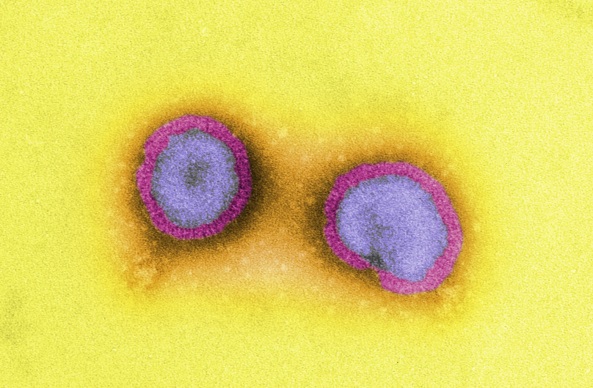Towards universal influenza vaccines – is Neuraminidase underrated?

Influenza viruses Source: Boller/Paul-Ehrlich-Institut
Influenza (the flu) is a serious infectious disease. Seasonal influenza epidemics cause 250,000 to 500,000 deaths world-wide each year, and the annual flu season results in considerable disease burden in Germany. The seasonal influenza epidemics are caused by different subtypes of the influenza A or by influenza B viruses. These influenza A virus strains differ – among other things – in their surface proteins hemagglutinin and neuraminidase.
The currently authorised inactivated vaccines against seasonal influenza are primarily designed to induce an immune response against hemagglutinin. For this purpose, the marketing authorisation specifies how much hemagglutinin antigen must be contained in the respective product.
The disadvantage of this antigen is that it often changes its surface structure in the course of an influenza season, leading to a reduction or loss of protection conferred by the seasonal influenza vaccines. This is one reason why annual adaptations of the strains in the vaccines are required and it is necessary to get a flu shot each year.
For neuraminidase, this situation is different: This protein is more stable, i.e. it less frequently acquires changes in its antigenicity. Up to now, however, its immunogenic potential – the ability to contribute to a protective immune response – has received little attention. This is the reason why no defined amounts of neuraminidase in influenza vaccines are required in today’s influenza vaccines.
Professor Veronika von Messling, head of the Veterinary Medicine Division at Paul-Ehrlich-Institut and her research team in collaboration with researchers of the German Centre for Infection Research (DZIF) and the Institute for Virology and Immunology at Mittelhäusern, Switzerland, have studied the potential of the neuraminidase antigen to trigger an immune response and confer protection against infection with different strains of the same subtype.
For their studies, they used the vesicular stomatitis virus (VSV) as vector vaccine to induce an immune response against hemagglutinin and neuraminidase proteins of various influenza virus strains in mice or ferrets. They found that neuraminidase-vaccinated animals were protected as effectively as animals vaccinated with the hemagglutinin protein against the matched influenza strain.
However, the neuraminidase-based vaccines also provided partial protection against influenza viruses with a different hemagglutinin subtype as long as they carried the same neuraminidase subtype. This protection could be predicted by measuring levels of cross-reactive neuraminidase-inhibiting antibody titres.
“Our results suggest that neuraminidase antigens have the potential to contribute to the development of influenza vaccines with broader protection,” stated Professor von Messling when explaining the results. She continued that in the next step, they are planning to optimise the neuraminidase protein to induce a protective immune response against all viruses of the same sub-type. Such optimised neuraminidase antigens could then be used to improve the protective effect of today’s influenza vaccines.
Original publication:
Walz L, Kays SK, Zimmer G, von Messling V (2018): Sialidase-Inhibiting Antibody Titers Correlate with Protection from Heterologous Influenza Virus Strains of the Same Neuraminidase Subtype.
J Virol Jun 20 [Epub ahead of print].
DOI: 10.1128/JVI.01006-18
The Paul-Ehrlich-Institut, the Federal Institute for Vaccines and Biomedicines, in Langen near Frankfurt/Main is a senior federal authority reporting to the Federal Ministry of Health (Bundesministerium für Gesundheit, BMG). It is responsible for the research, assessment, and marketing authorisation of biomedicines for human use and immunological veterinary medicinal products. Its remit also includes the authorisation of clinical trials and pharmacovigilance, i.e. recording and evaluation of potential adverse effects. Other duties of the institute include official batch control, scientific advice and inspections. In-house experimental research in the field of biomedicines and life science form an indispensable basis for the manifold tasks performed at the institute. The Paul-Ehrlich-Institut, with its roughly 800 members of staff, also has advisory functions nationally (federal government, federal states (Länder)), and internationally (World Health Organisation, European Medicines Agency, European Commission, Council of Europe etc.).
http://jvi.asm.org/content/early/2018/06/07/JVI.01006-18.abstract – Abstract of the publication
https://www.pei.de/EN/information/journalists-press/press-releases/2018/11-towar… – this press release on the Paul-Ehrlich-Institut Website
Media Contact
All latest news from the category: Life Sciences and Chemistry
Articles and reports from the Life Sciences and chemistry area deal with applied and basic research into modern biology, chemistry and human medicine.
Valuable information can be found on a range of life sciences fields including bacteriology, biochemistry, bionics, bioinformatics, biophysics, biotechnology, genetics, geobotany, human biology, marine biology, microbiology, molecular biology, cellular biology, zoology, bioinorganic chemistry, microchemistry and environmental chemistry.
Newest articles

Silicon Carbide Innovation Alliance to drive industrial-scale semiconductor work
Known for its ability to withstand extreme environments and high voltages, silicon carbide (SiC) is a semiconducting material made up of silicon and carbon atoms arranged into crystals that is…

New SPECT/CT technique shows impressive biomarker identification
…offers increased access for prostate cancer patients. A novel SPECT/CT acquisition method can accurately detect radiopharmaceutical biodistribution in a convenient manner for prostate cancer patients, opening the door for more…

How 3D printers can give robots a soft touch
Soft skin coverings and touch sensors have emerged as a promising feature for robots that are both safer and more intuitive for human interaction, but they are expensive and difficult…





















